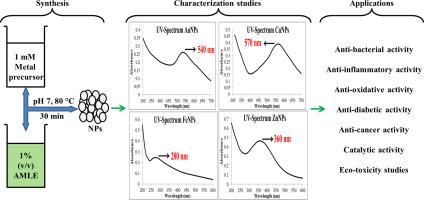Colloid and Interface Science Communications ( IF 4.7 ) Pub Date : 2020-07-31 , DOI: 10.1016/j.colcom.2020.100302 Aditya Velidandi , Ninian Prem Prashanth Pabbathi , Swati Dahariya , Rama Raju Baadhe

|
The present investigation highlights a unique, rapid, greener, economical and biological approach in the fabrication of gold (Au), copper (Cu), iron (Fe) and zinc (Zn) monometallic nanoparticles (MNPs) using Annona muricata aqueous leaf extract (AMLE) as a suitable reducing, capping and stabilizing agent. The bio-fabricated NPs were characterized using UV–Visible spectrophotometer and field emission scanning electron microscope with energy-dispersive x-ray spectroscopy (FESEM-EDX). Surface plasmon resonance (SPR) determined the formation of MNPs with maximum absorbance at 540, 570, 280 and 360 nm for Au, Cu, Fe and Zn-NPs respectively. Among all the bio-fabricated MNPs investigated CuNPs have showed superior activity for their anti-bacterial (against Escherichia coli), anti-inflammatory (egg albumin protein denaturation inhibition-51.46 ± 1.53 μg/mL), anti- diabetic (α-glucosidase activity inhibition-32.97 ± 2.51 μg/mL), anti-oxidative (DPPH free radical inhibition-63.44 ± 3.12 μg/mL) and anti-cancer (against K562 cancer cell line using MTT assay-53.34 ± 2.29 μg/mL) potentials. Whereas ZnNPs showed less-activity in anti-inflammatory and anti-oxidative (>100 μg/mL) and no activity was observed in anti-diabetic and anti-cancer assays compared to other investigated NPs. Both Cu- and Fe-NPs showed catalytic ability in the degradation of textile dyes in the presence of sodium borohydride (NaBH4). Cu and Fe-NPs degraded 94% of rhodamine-B (rh-B) under 35 and 90 min, whereas 94% of methyl orange (MO) under 25 and 70 min, respectively. Eco-toxicity studies carried out using Artemia nauplii have suggested that ZnNPs are less toxic (LC50 was >100 μg/mL after 24 h) compared to other investigated NPs.
中文翻译:

生物制备的单金属纳米颗粒的催化和生态毒性研究及其抗菌,消炎,抗糖尿病,抗氧化和抗癌潜力
本研究着重介绍了一种独特的,快速,绿色,经济和生物的方法,该方法使用Annona muricata水性叶提取物制备金(Au),铜(Cu),铁(Fe)和锌(Zn)单金属纳米颗粒(MNP)( AMLE)作为合适的还原剂,封端剂和稳定剂。使用紫外可见分光光度计和具有能量色散X射线光谱(FESEM-EDX)的场发射扫描电子显微镜对生物制成的NP进行了表征。表面等离振子共振(SPR)确定了金,铜,铁和锌NP分别在540、570、280和360 nm处具有最大吸光度的MNP的形成。在所有经过生物加工的MNP中,CuNP表现出了优异的抗菌活性(针对大肠杆菌)。),抗炎(抑制白蛋白蛋白变性-51.46±1.53μg/ mL),抗糖尿病(α-葡糖苷酶活性抑制-32.97±2.51μg/ mL),抗氧化(DPPH自由基抑制-63.44±3.12 (μg/ mL)和抗癌(使用MTT分析法针对K562癌细胞系-53.34±2.29μg/ mL)电位。相比于其他研究的NP,ZnNPs在抗炎和抗氧化(> 100μg/ mL)中的活性较低,在抗糖尿病和抗癌试验中未观察到活性。在硼氢化钠(NaBH 4)存在下,Cu-和Fe-NPs均显示出对纺织品染料降解的催化能力。Cu和Fe-NPs在25和70分钟内分别降解了94%的若丹明B(rh-B),而94%的甲基橙(MO)降解了。使用进行的生态毒性研究与其他研究过的NPs相比,无节幼体表明ZnNPs的毒性较小(24小时后LC 50 > 100μg/ mL)。











































 京公网安备 11010802027423号
京公网安备 11010802027423号